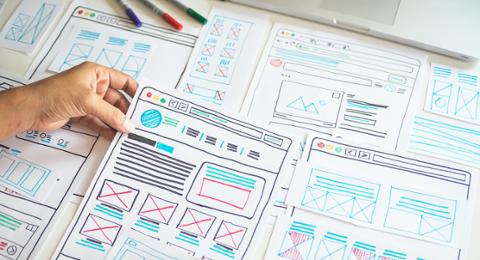If you’re looking for an exciting, multidisciplinary position that offers great pay and a bright future, user experience design (UX) could be the right fit for you. If you learn how to become a UX designer, you could have a significant impact on how users all over the world navigate apps, websites, and other types of software.
Not only is the current market hot, but demand for UX designers is projected to grow 10.9 percent over the next decade. With Lightcast (formerly Emsi Burning Glass) reporting a median starting salary of $82,000 for UX designers with zero to two years’ experience, there’s a lot to like, about the position.
Best of all, no matter what your background is, many of the skills and abilities you currently possess can be transferred into to this dynamic and evolving field. For example, those who become UX designers must often utilize “soft skills” (such as empathy and communication) to effectively convey results to stakeholders.
In this guide, we’ll share some tips from successful transitioners and what it takes to land your first job.
Perform a Skill Inventory and Gap Analysis
(Before we begin in earnest, let’s note that “UI” and “UX” are fundamentally different, although some folks will use the terms interchangeably. “UX” stands for “user experience design,” or how users interact with a product. Meanwhile, “UI” is “user interface design,” a digital-centric term for a product’s feel and interactivity. To maximize their salaries, UI/UX designers must show they’ve mastered both disciplines simultaneously.)
While UX focuses on a specific product, the role, team structure and skill requirements can vary from company to company. Therefore, the exploration stage is a critical starting place for matching your strengths, skills, and qualifications to an area of specialization—study yourself before you study the discipline.
For instance, Kay Cornier watched videos from UX designers and completed an introductory course to gain a clear understanding of the design process and how her background in psychology, customer service and marketing could help her transition into the field.
Her analysis revealed that she possessed some of the field’s most desirable qualities, like a customer-centric mindset, empathy, organizational skills, and an entrepreneurial approach. Keep in mind, though, that hiring managers also want to see mastery of design thinking, problem solving and fundamentals such as UX research, prototyping and usability testing.
For “transitioners” like Cornier, creating a skills inventory helps identify learning opportunities geared toward closing a specific talent and experience gap.
Learn the Fundamentals
From books to blogs, podcasts to tutorials, and even immersive bootcamps, today there are numerous resources (many free) for learning UX design and design thinking, noted Michael Degtyarev, senior UX/UI designer at Yardi Systems Inc. That’s just one reason why no two career paths or timelines are the same.
Degtyarev admits that his “visual design battery was running low” after a long career as a web developer and designer. Coming across the emerging discipline of UX at just the right time not only ignited his passion, it gave him a “sandbox” to practice the shift from “visually appealing” to “functionally pleasing” design work.
Degtyarev was able to learn UX fundamentals by reading books, and then trying and testing different methods and using feedback from his team to iterate quickly and move the design forward.
If you’re looking for suggestions, he says that every aspiring UX designer should read “The Elements of User Experience: User-Centered Design for the Web and Beyond (2nd Edition) (Voices That Matter)” by Jesse James Garrett.
Cornier, on the other hand, wanted to speed up the transition process, so she invested in a remote, 9-week bootcamp program.
No matter which learning regimen you choose, landing an offer will hinge on your ability to show off your skills mastery to recruiters, hiring managers, and other designers. “You still have to dig, and you still have to apply what you learned to design something,” Degtyarev noted.
Get Some Hands-On Experience
If you’re not working in a related field, how can you hone key “hard skills” such as user research, wireframing and prototyping, as well as demonstrate your problem-solving skills and application of the UX design process?
One thing you can do is conduct an unsolicited redesign, where you find a real UX problem in an existing website, app or feature and voluntarily redesign it. It could be a site you recently used, Cornier suggested. It may even be an existing app home screen or the interface of a customer-service kiosk (such as at an airport).
Treat your unsolicited redesign like a real project. Take a screen shot of your wireframe or mockup, and prepare to explain how you applied the UX design process to conceptualize and design your solution. Here are some excellent samples, to help you get started.
To persuade a hiring manager, a portfolio needs to include at least three case studies that use storytelling to showcase the challenges you faced, as well as the choices you made for key parts of the design and why.
If you’re struggling to come up with a UX challenge, you could also volunteer your services to a local non-profit or organizations in need of UX services. Network with product managers for ideas, or use a design brief generator to produce a fictitious project. Sites like Designership and Sharpen Design are also great sources of inspiration as well as opportunities to network and collaborate with experienced professionals.
Network and Apply
Even though the UX is a booming field, it still takes persistence and perseverance to land your first position, Cornier said.
Things that can help shorten the process and keep your spirits high include networking with hiring managers and industry professionals, tailoring your resume and value proposition toward each position, and devoting part of your time to expanding your skillset and portfolio and creating a robust online presence.
Reflecting on your motivations and strengths can also help you answer make-or-break “why” questions such as “Why are you interested in UX design?” and “Why should we hire you?”
Related UX Designer Jobs Resources:



